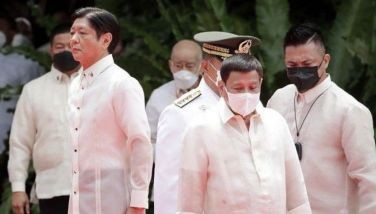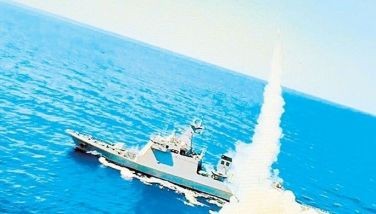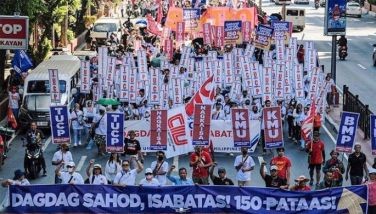Muslim-US cooperation began way back in the 1940s
February 13, 2006 | 12:00am
CARMEN, North Cotabato — It was in the early 1940s that Muslims cooperated with the American military — the reason why the local folk in this predominantly Muslim region have been ignoring the pockets of resistance by militant and minority groups opposing the joint RP-US military exercises here.
Many Muslim residents here and in surrounding towns are descendants of guerrillas, who, armed with their traditional bladed weapons and spears, helped the Americans fight the invading Japanese imperial forces entrenched in garrisons in areas now known as Digos City and the adjoining provinces of Bukidnon, Davao del Sur and North Cotabato.
According to local historians and Sharia lawyers, it was at the border of this town and what is now Pagalungan, Maguindanao that two legendary datus, Salipada Pendatun and Udtog Matalam, led a dozen fighters in organizing the resistance in 1942, known to the Japanese invaders as the "bolo battalion."
The two datus led two joint guerrilla forces composed of Maranaw sultans and chieftains of the Bilaan and Manobo tribes.
Despite the armed superiority and training of the Japanese soldiers, fighters of the bolo battalion, joined mostly by young men from Central Mindanao’s raya (upstream area) and the communities around the Liguasan delta, nonetheless kept the Japanese invaders on their toes.
The group, originally composed of 418 Maguindanaons, Maranaws and tribesmen from as far as Mt. Apo, were only armed with 39 Springfield rifles, a water-cooled caliber .30 machine gun, and two sets of obsolete binoculars.
But their familiarity with the terrain gave them the advantage over the enemy, keeping them isolated in their garrisons while killing more of them in surprise attacks and ambuscades.
The influential figure that encouraged young Muslim leaders like Pendatun, Matalam and the leaders of the Manalao and Mindalano clans in areas now known as Lanao del Sur was Edward Kuder, an American teacher.
Kuder was the school superintendent in Muslim areas now occupied by the provinces of Lanao, Sulu, and Cotabato during the 1920s.
As a mentor, Kuder adopted more than two dozen "selected, intelligent" sons of datus in the areas under his jurisdiction.
Pendatun, son of a sultan, was to become Kuder’s most intelligent pupil, who learned from him to speak proficient English.
Pendatun, at a very tender age, used Kuder as his middle name in all of his records.
When World War II broke out, most of Kuder’s foster children were already adolescents or in their early 20s, some of them already teachers in remote areas in Central Mindanao.
One of Kuder’s adopted sons, Datu Mohammad Adil, who was to retire as colonel in the defunct Philippine Constabulary in 1970, acted as his courier in contacting his other foster children.
Kuder, through Adil, encouraged his foster children to organize and lead armed resistance against the Japanese in areas where they wield influence.
Now old and frail, Adil still has a good memory of his exploits during the war.
Adil recalled his experience of traveling by foot in areas surrounding Lake Lanao to North Cotabato and treading the marshy areas of Maguindanao to deliver letters from Kuder to his former students in urging them to help US forces fight the Japanese invaders.
"We slept under big trees. The mosquitoes were so terrible," he said.
"Sometimes there were sleepless nights because of heavy monsoon. Despite the difficulties, we managed to contact those Mr. Kuder wanted to reach through letters," Adil said.
Pendatun and Gumbay Piang, a teacher in a school in Dulawan (now Datu Piang, Maguindanao), were the first to respond to Kuder’s challenge.
Piang subsequently gathered their relatives and made them swear over the Qur’an to fight the invaders of their homeland.
Members of two big Maranaw clans, Mindalano and Manalao, whose leaders were close friends of Kuder, also joined and pledged to fight the Japanese.
"(The) fighters then were so ferocious. With very limited weaponry, they ambushed Japanese and attacked them with Springfield bolt-action rifles, bows and poisoned darts from a distance. The zeal of helping the US government was so enormous. We fought without expecting anything from the Americans in return," Adil said.
Contemporary historians said the Muslim fighters reached as far as what are now Makilala in North Cotabato and Digos City, at the center of Davao del Sur, in stalking the Japanese.
An 80-year-old Baimasla Mohammad, a daughter of Karim who was a member of the bolo battalion during the war, recalls her father’s frequent gathering of toxic sap of a very rare tree in forested areas of this town and Damulog, Bukidnon, for their poisoned darts and arrows.
"Immediately after preparing the concoction, he and his companions would leave right away, report to their leader, Datu Salipada, who, in turn, will have the poisoned darts and arrows delivered to his forces in the field," Mohammad said in the Maguindanaon dialect.
One of the most battle-hardened warriors here who fought the Japanese was Kagui Magandingan Manalos, an adopted brother of Matalam, who became governor of the Empire province of Cotabato about a decade after World War II.
Pendatun, on the other hand, became member of the old Philippine Congress, serving his district from the late 1950s until 1972 when the entire country was placed under martial law by the late strongman Ferdinand Marcos.
Manalos, at the ripe age of 75, along with his relatives, fought the Army from 1992 to 1995 in Barangay Kibines in opposing the construction of what is now the Malitubog-Maridagao Irrigation Project.
The Manalos family was so apprehensive then that the project, if completed, would only trigger the influx of non-Muslim settlers and, in effect, displace the area’s native inhabitants.
The 200-hectare camp of the Army’s 602nd Brigade, where the ongoing RP-US military training is being held, was, in fact, named Camp Lucero, in honor of an Army ranger, Maj. Alex Lucero who was killed in a three-hour firefight with the group of Manalos in 1993.
For the still surviving members of the Muslim guerrilla forces that fought the Japanese under the US flag in Central Mindanao, they called for all history books to be rewritten to highlight the contribution of the Muslim people in Mindanao in the struggle for Philippine independence.
"My great grandfathers Datu Salipada Pendatun and Datu Udtog Matalam both passed away keeping in their hearts the vivid and colorful memories of the Muslim-US cooperation during World War II," said the 37-year-old politician in the second district of Maguindanao.
Many Muslim residents here and in surrounding towns are descendants of guerrillas, who, armed with their traditional bladed weapons and spears, helped the Americans fight the invading Japanese imperial forces entrenched in garrisons in areas now known as Digos City and the adjoining provinces of Bukidnon, Davao del Sur and North Cotabato.
According to local historians and Sharia lawyers, it was at the border of this town and what is now Pagalungan, Maguindanao that two legendary datus, Salipada Pendatun and Udtog Matalam, led a dozen fighters in organizing the resistance in 1942, known to the Japanese invaders as the "bolo battalion."
The two datus led two joint guerrilla forces composed of Maranaw sultans and chieftains of the Bilaan and Manobo tribes.
Despite the armed superiority and training of the Japanese soldiers, fighters of the bolo battalion, joined mostly by young men from Central Mindanao’s raya (upstream area) and the communities around the Liguasan delta, nonetheless kept the Japanese invaders on their toes.
The group, originally composed of 418 Maguindanaons, Maranaws and tribesmen from as far as Mt. Apo, were only armed with 39 Springfield rifles, a water-cooled caliber .30 machine gun, and two sets of obsolete binoculars.
But their familiarity with the terrain gave them the advantage over the enemy, keeping them isolated in their garrisons while killing more of them in surprise attacks and ambuscades.
Kuder was the school superintendent in Muslim areas now occupied by the provinces of Lanao, Sulu, and Cotabato during the 1920s.
As a mentor, Kuder adopted more than two dozen "selected, intelligent" sons of datus in the areas under his jurisdiction.
Pendatun, son of a sultan, was to become Kuder’s most intelligent pupil, who learned from him to speak proficient English.
Pendatun, at a very tender age, used Kuder as his middle name in all of his records.
When World War II broke out, most of Kuder’s foster children were already adolescents or in their early 20s, some of them already teachers in remote areas in Central Mindanao.
One of Kuder’s adopted sons, Datu Mohammad Adil, who was to retire as colonel in the defunct Philippine Constabulary in 1970, acted as his courier in contacting his other foster children.
Kuder, through Adil, encouraged his foster children to organize and lead armed resistance against the Japanese in areas where they wield influence.
Now old and frail, Adil still has a good memory of his exploits during the war.
Adil recalled his experience of traveling by foot in areas surrounding Lake Lanao to North Cotabato and treading the marshy areas of Maguindanao to deliver letters from Kuder to his former students in urging them to help US forces fight the Japanese invaders.
"We slept under big trees. The mosquitoes were so terrible," he said.
"Sometimes there were sleepless nights because of heavy monsoon. Despite the difficulties, we managed to contact those Mr. Kuder wanted to reach through letters," Adil said.
Pendatun and Gumbay Piang, a teacher in a school in Dulawan (now Datu Piang, Maguindanao), were the first to respond to Kuder’s challenge.
Piang subsequently gathered their relatives and made them swear over the Qur’an to fight the invaders of their homeland.
Members of two big Maranaw clans, Mindalano and Manalao, whose leaders were close friends of Kuder, also joined and pledged to fight the Japanese.
"(The) fighters then were so ferocious. With very limited weaponry, they ambushed Japanese and attacked them with Springfield bolt-action rifles, bows and poisoned darts from a distance. The zeal of helping the US government was so enormous. We fought without expecting anything from the Americans in return," Adil said.
Contemporary historians said the Muslim fighters reached as far as what are now Makilala in North Cotabato and Digos City, at the center of Davao del Sur, in stalking the Japanese.
An 80-year-old Baimasla Mohammad, a daughter of Karim who was a member of the bolo battalion during the war, recalls her father’s frequent gathering of toxic sap of a very rare tree in forested areas of this town and Damulog, Bukidnon, for their poisoned darts and arrows.
"Immediately after preparing the concoction, he and his companions would leave right away, report to their leader, Datu Salipada, who, in turn, will have the poisoned darts and arrows delivered to his forces in the field," Mohammad said in the Maguindanaon dialect.
One of the most battle-hardened warriors here who fought the Japanese was Kagui Magandingan Manalos, an adopted brother of Matalam, who became governor of the Empire province of Cotabato about a decade after World War II.
Pendatun, on the other hand, became member of the old Philippine Congress, serving his district from the late 1950s until 1972 when the entire country was placed under martial law by the late strongman Ferdinand Marcos.
Manalos, at the ripe age of 75, along with his relatives, fought the Army from 1992 to 1995 in Barangay Kibines in opposing the construction of what is now the Malitubog-Maridagao Irrigation Project.
The Manalos family was so apprehensive then that the project, if completed, would only trigger the influx of non-Muslim settlers and, in effect, displace the area’s native inhabitants.
The 200-hectare camp of the Army’s 602nd Brigade, where the ongoing RP-US military training is being held, was, in fact, named Camp Lucero, in honor of an Army ranger, Maj. Alex Lucero who was killed in a three-hour firefight with the group of Manalos in 1993.
For the still surviving members of the Muslim guerrilla forces that fought the Japanese under the US flag in Central Mindanao, they called for all history books to be rewritten to highlight the contribution of the Muslim people in Mindanao in the struggle for Philippine independence.
"My great grandfathers Datu Salipada Pendatun and Datu Udtog Matalam both passed away keeping in their hearts the vivid and colorful memories of the Muslim-US cooperation during World War II," said the 37-year-old politician in the second district of Maguindanao.
BrandSpace Articles
<
>
- Latest
- Trending
Trending
Latest
Trending
Latest
Recommended




























